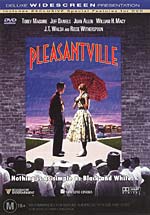 To Kill a Mockingbird
To Kill a Mockingbird
1962
Director: Robert Mulligan
Starring: Gregory Peck, Mary Badham, Phillip Alford, Brock Peters
 Pleasantville
Pleasantville
1997
Director: Gary Ross
Starring: Tobey Maguire, Reese Witherspoon, Joan Allen, William H Macy
The achievement of To Kill a Mockingbird was that not only was the movie's story faithful to the original, the mood, the tone, was immaculately captured.
The Depression-era small town used for the movie was purpose-built on a Hollywood back lot, using existing homes scheduled for demolition. Harper Lee, the novel's author, approved of the script and the movie itself. Aside from Gregory Peck (who won the Best Actor Academy Award), mostly unknown actors were used, including Badham and Alford, the two children upon whom the movie is centred, and Robert Duvall in his movie debut as Boo Radley.
The movie was filmed in black and white at a time when colour was the Hollywood norm. Despite this another Oscar was earned for Art Direction. This makes the DVD all the more disappointing. Although presented in a widescreen (1.85:1) ratio, the DVD is not anamorphically encoded and consequently suffers from a lack of resolution of detail. This matters little on the closeups of faces, but there are many distant shots and much of the movie is set in a packed courtroom, the occupants of which seem on this disc to be only sketchily represented. Even the regular outdoor shots, with their high contrast and lush Southern US foliage, look busy and borderline aliasing constantly distracts the eyes.
The audio is mono and presented in 1.0 format, allowing a mere 96kb/s Dolby Digital encoding rate to be used. A 90 minute documentary fills out the space available on the dual layer disc. Interesting as this is, I would have preferred to surrender this for anamorphic encoding of the feature.
From this slightly silly premise, explained only by the satisfied closing smile of the TV Repairman (Don Knotts), develops a movie which is ultimately quite moving, and largely satisfying in terms of its own internal logic. But not perfectly satisfying, for example toilet bowls do not exist in Pleasantville, but sexual organs apparently do.
A brief listen to Ross' audio commentary suggests that there is also a great deal of subtle imagery that escapes casual viewing, such as the evolving Indian profile on the test pattern, and the firemen unintentionally adopting the classic pose of the Marines on Iwo Jima -- while rescuing a cat from a tree. The main messages are conveyed with considerably less subtlety.
The technical wizardry involved in turning the black and white world of Pleasantville into colour, piece by piece, is considerable, even if the trigger seems to be the slightly dissatisfying 90s idea that emotional release is necessarily good. The video is presented in 1.85:1 widescreen, anamorphically enhanced, and finely done indeed. The device of re-colourising items in a primarily black and white picture brings a new appreciation of colour photography.
The 5.1 channel Dolby Digital sound is smooth and clean, with Randy Newman's score beautifully presented. As is Roadshow's usual practice, a two channel Dolby Digital track is also provided. This is said to be 'Dolby Surround 2.0' on the packaging, but its does not carry a Dolby Pro Logic flag.
Running time: 123 minutes
Aspect: 1.85:1 non-anamorphic
Sound track: English, German, Italian, French, Spanish all Dolby Digital 1.0, 96kb/s
Subtitles: English, French, Portuguese, Danish, Finnish, Swedish, Norwegian, German, Dutch, Czech, Polish, Turkish, Hungarian, Bulgarian
Features: Documentary: 'Fearful Symmetry - The Making of To Kill A Mockingbird' (90 mins), Production notes, Cast and Crew, Trailer, Commentary track
Running time: 119 minutes
Aspect: 1.85:1 anamorphic
Sound track: English, Dolby Digital 5.1, 448kb/s, and Dolby Digital 2.0, 192kb/s
Subtitles: English
Features: 'The Art of Pleasantville' documentary (32 mins), Music video, Trailer, Commentary track